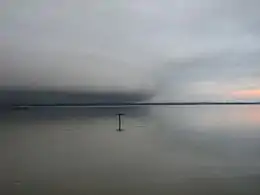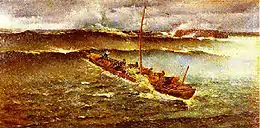Galerna
A galerna is a sudden and violent storm with strong wind gusts from the west or northwest that affects coastal areas of the Bay of Biscay, predominantly during spring and fall. It especially affects the central and eastern part of the Spanish north coast (Asturias, Cantabria, and the Basque provinces of Biscay and Gipuzkoa) and the southwestern region of France (Touraine, Berry, Deux-Sèvres, Vendée, French Basque Country, Quercy, and Brittany). The name comes from French galerne and that originates from Breton (gwalarn), a wind from the northwest.

Description
It is caused by the passage of a channeled cold coastal front, a type of coastally trapped disturbance. They usually occur during warm and calm days when a cold front causes a sudden change in wind direction and intensity that can exceed 100 km/h. The sky darkens and there is a sudden decrease in temperature of up to 12°C in 20 minutes, rapid drop in atmospheric pressure, and a rise in relative humidity. The resulting wave heights in the coastal ocean range from rough to very high on the Douglas sea scale.

Because of the associated weather and sea condition change, they are some of the meteorological events most feared by mariners and fishermen in the Bay of Biscay, especially historically. Currently, weather forecast models are able to predict the precursor conditions to galernas, reducing their potential risks, but predicting the exact timing of their occurrence remains a challenge.
Galernas throughout history

Galernas have caused many fatalities throughout history. One of the most damaging events occurred on April 20, 1878 and it was known as the "Galerna of Easter Saturday".[1] It is featured in the novel Sotileza by José María de Pereda. During that day, fishermen tried to reach the coast in their launch boats to no avail, while their families watched from shore. 322 fishermen died along the Cantabrian coast (132 from Cantabria and 190 basque) and it caused a commotion throughout the country. The response to this disaster caused the introduction of several maritime safety improvements (e.g., flush deck, weather reports, search and rescue operations). Even with these improvements, many galernas continued causing fatalities.
| Date | Deaths | Notes |
|---|---|---|
| 1842 | It affected mostly Laredo. | |
| 1873 | Almost 50 boats lost along the coast all the way to Bayonne. | |
| April 20, 1878 | 322 | Known as the Easter Saturday Galerna. |
| 1879 | Over two dozen fishing boats sunk. | |
| 1882 | Several boats lost in Santander. | |
| April 26, 1890 | 54 | Four boats sunk in Santander: Santa Catalina, San Pedro, Nuestra Señora del Carmen y Buenas Noches. |
| 1899 | The boat Josefita sunk in Santoña and the fishermen were safe by the yacht Goizeko Izarra, owned by Ramon de la Sota. | |
| July 12, 1908 | 49 | Several boats disappeared along the coast of Asturias, Cantabria and Vizcaya: Carmen Margarita, Josefa; Jesús, María y José; San Ignacio; San Jerónimo; Concepción; Antigua ; Santa Bárbara and Salomé. |
| August 12 – 13, 1912 | 141 | 119 fishermen died in Bermeo: one in every 10 fishermen from the town died.[2] |
| December 20, 1914 | Four boats sunk in Suances and Comillas: Encarnación, Santa Cecilia, María and Landasun. | |
| July 12 – 13, 1961 | 83 | The fishing fleet of skipjack tuna was caught far from shore by the galerna.[3] |
| June 7, 1987 | 8 | Frontal galerna that affected Asturias, Cantabria, the Basque Contry and the southwest coast of France. A wind gust of 140 km/h were measured in Gijón.[4] |
See also
References
- Carmen Gozalo de Andrés (2002). "Galernas de Ayer y de Hoy"
- El Comercio (2011). "50 años de la maldita galerna". Retrieved 2 October 2011.
- "naufragios.es - GALERNA Con estas palabras definió don... | Facebook". Es-es.facebook.com. Retrieved 2020-05-27.
- "Agencia Estatal de Meteorología - AEMET. Gobierno de España" (in Spanish). Aemet.es. Retrieved 2020-05-27.
